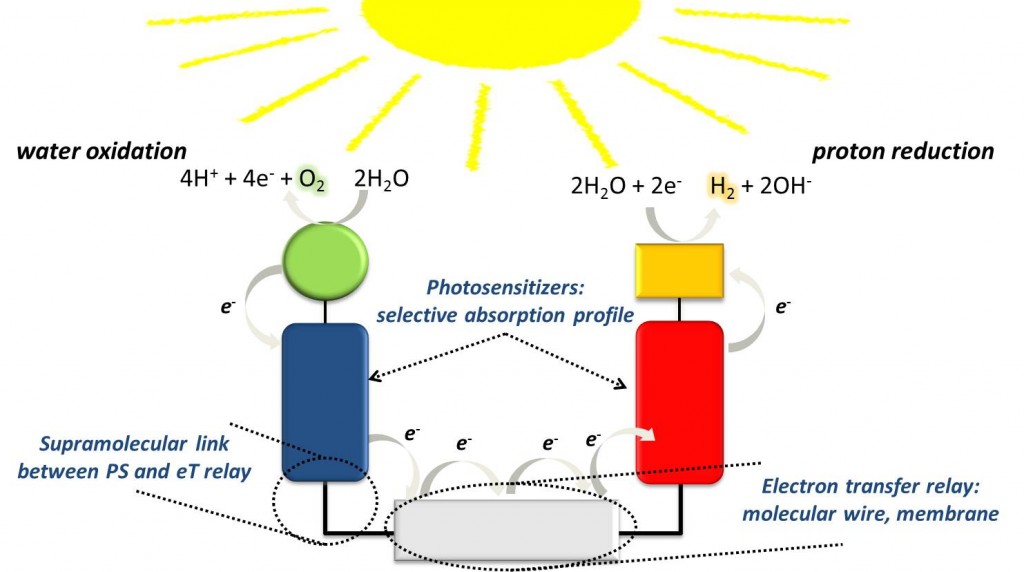A key aspect of our group’s research program is the design and discovery of new molecular and supramolecular architectures which achieve artificial photosynthesis.
 In the design of new structures for artificial photosynthesis, we draw upon what is known about the protein reaction center structures which accomplish natural photosynthesis. Effective artificial photosynthesis requires precise photon, proton, and electron management through disparate time and length scales: photon absorption in femto- to picoseconds, charge separation in pico- to nanoseconds, substrate approach and binding in nano- to microseconds, followed by bond formation and product release.
In the design of new structures for artificial photosynthesis, we draw upon what is known about the protein reaction center structures which accomplish natural photosynthesis. Effective artificial photosynthesis requires precise photon, proton, and electron management through disparate time and length scales: photon absorption in femto- to picoseconds, charge separation in pico- to nanoseconds, substrate approach and binding in nano- to microseconds, followed by bond formation and product release.
 Our approach to new supramolecular designs is modular in nature. This allows us to select and optimize molecular modules to accomplish a single step of artificial photosynthesis and then link these modules through specific interactions including metal coordination bonding, hydrogen bonding, or electrostatic interactions. A distinct advantage of this approach is the ability to incorporate identical molecular modules in a variety of environments including supramolecular assemblies, metal-organic frameworks, or biohybrids and track the impact of coordination and environment on the functional parameters relevant to solar energy conversion.
Our approach to new supramolecular designs is modular in nature. This allows us to select and optimize molecular modules to accomplish a single step of artificial photosynthesis and then link these modules through specific interactions including metal coordination bonding, hydrogen bonding, or electrostatic interactions. A distinct advantage of this approach is the ability to incorporate identical molecular modules in a variety of environments including supramolecular assemblies, metal-organic frameworks, or biohybrids and track the impact of coordination and environment on the functional parameters relevant to solar energy conversion.
 Our group has a dedicated lab for organic and inorganic synthesis with four 6-foot fume hoods and all of the necessary equipment to perform complex, multi-step synthetic schemes. Shared divisional facilities for structural characterization include several NMR spectrometers, mass spectrometers, and powder X-ray diffraction, several of which are housed in labs right down the hall from our synthetic labs. In-house characterization equipment includes a Beckman-Coulter UV-Vis spectrometer, PTI fluorimeter, and a BAS electrochemical workstation. Catalytic activity of newly synthesized photocatalysts can be tested using a variety of light sources (Xe lamps, LEDs) and headspace analysis using a Varian micro-GC. Synthesis and routine characterization of new photosynthetic architectures is tightly coupled to our group’s expertise in high-resolution, time-resolved physical characterization including optical and X-ray spectroscopy, X-ray scattering, and EPR spectroscopy.
Our group has a dedicated lab for organic and inorganic synthesis with four 6-foot fume hoods and all of the necessary equipment to perform complex, multi-step synthetic schemes. Shared divisional facilities for structural characterization include several NMR spectrometers, mass spectrometers, and powder X-ray diffraction, several of which are housed in labs right down the hall from our synthetic labs. In-house characterization equipment includes a Beckman-Coulter UV-Vis spectrometer, PTI fluorimeter, and a BAS electrochemical workstation. Catalytic activity of newly synthesized photocatalysts can be tested using a variety of light sources (Xe lamps, LEDs) and headspace analysis using a Varian micro-GC. Synthesis and routine characterization of new photosynthetic architectures is tightly coupled to our group’s expertise in high-resolution, time-resolved physical characterization including optical and X-ray spectroscopy, X-ray scattering, and EPR spectroscopy.
Recent and relevant publications include:
Li, Y.-S. Chen, K. L. Mulfort. Synthetic control over structure in bimetallic Ru(III)-Co(II) metal-organic frameworks, CrystEngComm, 2015, 17, 1005-1009.
A. Mukherjee, O. Kokhan, J. Huang, J. Niklas, L. X. Chen, D. M. Tiede, K. L. Mulfort. Detection of a charge-separated catalyst precursor state in a linked photosensitizer-catalyst assembly, Phys. Chem. Chem. Phys., 2013, 15, 21070-21076.
K. L. Mulfort, A. Mukherjee, O. Kokhan, P. Du, D. M. Tiede. Structure-based analyses of solar fuels catalysts using in situ X-ray scattering, Chem. Soc. Rev., 2013, 42, 2215-2227.
J. Huang, K. L. Mulfort, P. Du, L. X. Chen. Photodriven charge separation dynamics in CdSe/ZnS core/shell quantum dots/cobaloxime hybrid for efficient hydrogen production, J. Am. Chem. Soc., 2012, 134, 16472.
K. L. Mulfort, D. M. Tiede. Supramolecular cobaloxime assemblies for H2 photocatalysis: an initial structure-function analysis, J. Phys. Chem. B, 2010, 114, 14572-14581.
Contact Karen Mulfort for more information.

